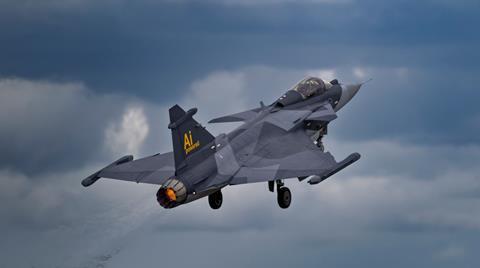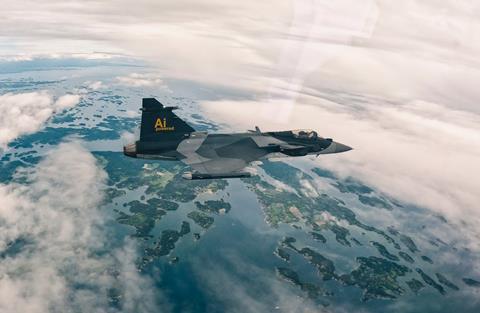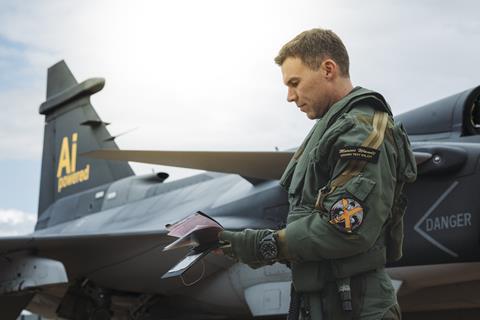Saab is claiming a world-first in the use of an installed artificial intelligence (AI) agent to enable beyond-visual-range (BVR) dogfighting during flight trials of its Gripen E.
Dubbed Project Beyond, the ongoing activity is being conducted by the Swedish airframer in partnership with German AI specialist Helsing. Its unique aspect, the partners claim, is the ability to incorporate the technology within a production-standard aircraft’s normal software platform.
Performed in civil airspace in Sweden, the three sorties completed so far have involved the AI agent – named Centaur and optimised for BVR engagements – autonomously manoeuvering the jet up to the point of providing a firing solution for its human pilot.

Two flights were conducted on 28 May, followed by another on 3 June. The most recent sortie also involved the use of a Gripen D as an opposing aircraft “in a series of dynamic BVR scenarios with real-time data integration utilising sensor data to track the target aircraft”, Saab says. The work simulated the use of a generic long-range air-to-air missile.
“The team tested Centaur’s adaptability by varying starting distances, speeds, aspects, and even disabling C2 [command and control] data to assess its robustness,” it adds.
First discussions between Saab and Helsing took place “last autumn”, with the project formally launched on 1 January 2025 and integration activities starting in mid-March.
“The real work started in April,” says Peter Nilsson, head of advanced programmes at Saab Aeronautics. “Eight weeks later we took off with the BVR agent.”
The activity is fully funded by Sweden’s Defence Materiel Administration, as part of a broader concept and demonstration programme linked to future fighter systems for the nation.
Johan Segertoft, who heads Saab’s Gripen business unit and has been intricately involved in the E-model’s software architecture since the programme’s early days, describes the recent achievement as “the coolest thing that has ever happened”.
The ability to use – and rapidly modify – the AI agent stems from the Gripen E’s design, which separates its safety-critical software from other software and systems. That means the technology developed and tested in partnership with Helsing could be uploaded into the aircraft’s avionics without affecting other equipment.
“We are not deploying Helsing software in a standalone computer hidden away in the aircraft – we are deploying it in the heart of the avionics platform. It is communicating with our flight control systems, our sensors, with everything,” Segertoft says.

Antoine Bordes, Helsing’s vice-president artificial intelligence, notes that Centaur – which had been in development since 2023 – employs ‘re-enforcement learning’. By using more than one agent simultaneously, “Centaur is learning in the simulator against itself,” he notes, with such work capable within hours or days of replicating the equivalent of perhaps 30 to 50 years of operational flying.
“This is the proof point externally to what this aircraft can do,” Segertoft says of Project Beyond. “We are blurring the lines between now and the future. When everyone else is doing visions for 2035, 2040, 2045, we are talking about what do we want to deploy now? How can we change everything now?
“We have proven ‘code in the morning, fly in the afternoon’. Our new mission should be code in the evening, deploy live with a customer in the morning, and get operational insights in the afternoon.
“We are the disruptor in military aviation, and we continue to be that,” he claims.
Noting that the Gripen E “is the only aircraft in the world capable of doing this”, he says: “We could deliver this [AI-enabled functionality] to a customer if they would like to continue to evaluate the capability with us.”
“The main goal for Saab is to see if we can take another company’s software and put it straight into the Gripen E,” Nilsson says. “The second goal is to see what an AI-trained agent can do to support a Gripen pilot in a real combat.
“While the rest of our partners and competitors are stuck setting up big programmes, we are moving in a speedy way, delivering capabilities here and now,” he says. “There are endless possibilities where we can see AI supporting a Gripen pilot, or in unmanned platforms.”
“We have been developing human-machine collaboration for a long time, allowing the Gripen C but now even more the E to take a lot of decisions on its own,” Segertoft says. “The pilot is still the commander of the aircraft, and will continue to be, but with the assistance of for example a BVR agent, you are opening up a lot of free brain power in that commander to do other things.
“This is just a natural progression. We are now moving to be a battlefield commander sitting in an aircraft.”
Referring to phrases like fifth- and sixth-generation as being superfluous in the fighter world, Segertoft states: “Software will always out-compete the physical world. In software there are no generations – there’s only speed.”
Meanwhile, asked to describe his experience in the cockpit for one of the AI-enabled flights, Saab chief innovation officer Marcus Wandt says: “You are along for the ride, when you activate the AI agent.
“It’s not unpredictable,” the test pilot and Swedish astronaut notes of the experience. “But what is interesting is the agent becomes creative sometimes, in exactly the same way as a human, sometimes it’s faking an engagement, pulling out and then coming back and doing it again.”

The AI agent is able to manoeuvre using the aircraft’s full operating envelope, and Wandt says: “we haven’t seen any exceedance or disconnect of those functions that we are using in the flight control system”.
“It’s not a given who will win, which is exciting, and you have to be on your game as a pilot,” Wandt says. Looking ahead, he notes: “Training this for new scenarios – you will have to think differently about air combat.
“Right now, there are still pilots out there who will have a chance,” he says. “But that will change fast.”
Further flights in support of Project Beyond will be conducted through the rest of this year, with these to further the complexity of the work conducted to date.
.png)



